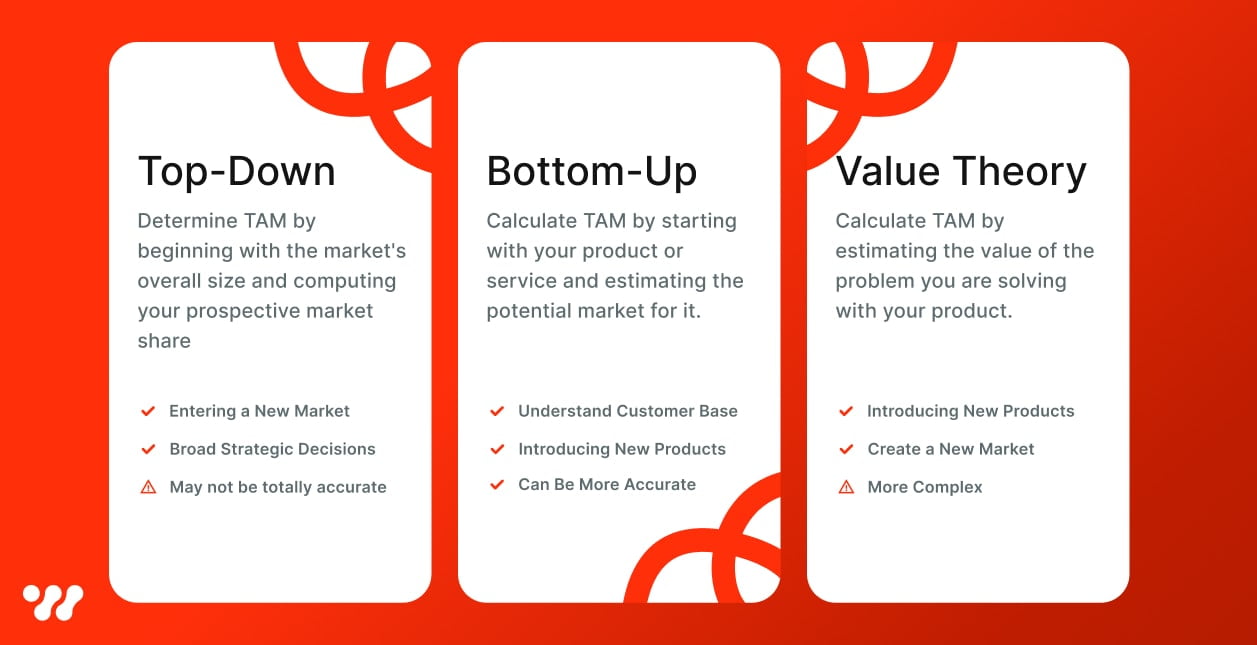
In the healthcare industry, understanding the size and scope of your target market is crucial to success. Total Addressable Market (TAM) Identification helps businesses identify the potential revenue opportunity for their products or services within a given market. By identifying the TAM, companies can develop a more effective strategy for growth and expansion. This is particularly important in healthcare, where changes in regulations and technological advancements can create significant market opportunities.
In this article, we’ll explore how Healthcare TAM Identification can help companies dominate the market, and provide some practical tips for identifying the TAM in your particular niche. Whether you’re a healthcare startup or an established organization, TAM Identification can help you develop a winning Marketing Strategy and stay ahead of the competition.
In the highly competitive healthcare industry, identifying your TAM is critical to the success of your business. Without a clear understanding of the potential size and scope of your market, you risk missing out on valuable opportunities and leaving money on the table.
TAM Identification allows healthcare companies to estimate the market potential for their products or services. By calculating the total number of potential customers and the average revenue per customer, you can determine the total revenue opportunity within your market. This can help you make informed decisions about product development, pricing, and marketing.

Healthcare TAM Identification can also help you identify different market segments within your target market. By segmenting the market based on factors such as demographics, geography, and customer behavior, you can develop targeted marketing campaigns and tailor your products or services to meet the specific needs of each segment.
Gathering information about your target market is the first stage in identifying market segments. Demographic information such as age, gender, income, level of education, and location may be included. Also, you can get information on consumer behavior, such as past purchases, web surfing patterns, and social media usage.
Data analysis is the following stage after data collection in order to spot patterns and trends. To aid in data visualization and the discovery of significant insights, you might employ software and tools for data analysis. Find out what your customers have in common and look for groups that have similar requirements, interests, or behaviors.
Create buyer personas or customer profiles that represent the various market categories based on your analysis. The demographics, behavior, needs, and pain areas of each consumer should be described in the profile. These profiles can be used to create segment-specific marketing campaigns and to customize your goods and services to satisfy each group’s unique requirements.
Make sure to test and tweak your marketing initiatives as you create them to make sure they appeal to all of your target market’s subgroups. Improve your campaigns and offerings using A/B testing and consumer feedback, and be prepared to change your approach as necessary to best serve your target audience.
By identifying your TAM, you can gain a competitive edge in the healthcare industry. Healthcare TAM Identification allows you to identify market trends, customer needs, and areas of untapped potential. Armed with this information, you can develop a more effective strategy for growth and expansion, and stay ahead of the competition.
TAM Identification provides healthcare companies with valuable insights that can inform business decisions. By understanding the size and scope of your market, you can make more informed decisions about product development, pricing, and marketing. This can help you optimize your resources, minimize risks, and maximize profits.
Check out this resource about data and identifying your TAM provided by ZoomInfo:
To determine the potential revenue opportunity for your product or service in the healthcare industry, it’s important to calculate your Total Addressable Market (TAM). There are three main approaches to calculating TAM: top-down, bottom-up, and value theory.
Using the top-down method, you can determine TAM by beginning with the market’s overall size and computing your prospective market share. To begin, you would count the total number of people or enterprises in your target market. The overall market value would then be calculated by dividing the number of possible consumers by the typical revenue per client. Finally, you would use information from similar businesses or goods to assess your prospective market share.
The top-down strategy works well for businesses that are entering a new market and have little knowledge of the target market. It is also a fantastic choice for businesses that need to swiftly assess the size of the market in order to make broad strategic decisions. The top-down technique relies on assumptions about the market that may not be totally accurate, which means it can be less accurate than other approaches.
Suppose you are launching a healthcare technology platform that provides telehealth consultations to patients in the United States. Using the top-down approach, you might estimate your TAM as follows:
Identify the total number of potential customers: According to the U.S. Census Bureau, the total population of the United States is approximately 331 million people. However, not all of these people are potential customers for your healthcare technology platform.
Determine the size of your target market: To estimate the size of your target market, you might look at data on healthcare spending in the United States. According to the Centers for Medicare & Medicaid Services, national health expenditures in the U.S. were projected to reach $3.8 trillion in 2020. You might estimate that a portion of this spending, say 10%, represents the potential market for telehealth consultations.
Estimate your potential market share: To estimate your potential market share, you might look at data on the telehealth industry in the United States. According to a report from Grand View Research, The U.S. telehealth market size was valued at USD 23.5 billion in 2021. Based on this data, you might estimate that your healthcare technology platform could capture 5% of the U.S. telehealth market in the next few years.
Multiply the total potential market size by your potential market share: To estimate your TAM, you would multiply the total potential market size by your estimated market share. Using the figures from above, your TAM would be:
$3.8 trillion x 10% (potential market) x 5% (estimated market share) = $19 billion TAM
Of course, this is just a hypothetical example, and the actual calculation will depend on the specific characteristics of your product or service and your target market. The key is to gather as much data as possible about the size and characteristics of your market and use that data to estimate the potential revenue opportunity for your business using the top-down approach.
The bottom-up approach to calculating TAM involves starting with your product or service and estimating the potential market for it. To do this, you would identify your target customer and estimate the number of potential customers. You would then estimate the total revenue opportunity by multiplying the number of potential customers by the price per unit. Finally, you would estimate your potential market share by using data from similar products or companies.
The bottom-up approach is best suited for companies that are already operating in a market and have a good understanding of their customer base. It is also a good option for companies that are introducing a new product or service and need to estimate demand based on specific customer needs. The bottom-up approach can be more accurate than the top-down approach, as it is based on more specific data about customer behavior and purchasing patterns.
For example, if you are selling a healthcare product to a specific demographic in the United States and estimate that there are 10 million potential customers in your market, with a price per unit of $100 and an annual purchase frequency of 2 times per year, your TAM using the bottom-up approach would be:
10 million potential customers x $100 per unit x 2 purchases per year = $2 billion TAM
Of course, this is just a hypothetical example, and the actual calculation will depend on the specific characteristics of your product or service and your target market. The key is to gather as much data as possible about your target customer and use that data to estimate the potential revenue opportunity for your business.

The value theory approach to calculating TAM involves estimating the value of the problem you are solving with your product or service. To do this, you would identify the total number of potential customers who have the problem you are solving and estimate the value of solving that problem for each customer. You would then estimate the total revenue opportunity by multiplying the number of potential customers by the value of solving the problem. Finally, you would estimate your potential market share by using data from similar products or companies.
The value theory approach is best suited for companies that are introducing a new product or service that solves a specific problem or meets a specific need. It is also a good option for companies that are looking to create a new market or disrupt an existing market with an innovative solution. The value theory approach can be more complex than other methods, as it requires a deep understanding of customer needs and the financial impact of solving those needs. However, it can also be more effective in estimating the potential revenue opportunity, as it is based on a clear understanding of the value that the product or service creates for the customer.
Suppose you are developing a healthcare technology platform that uses machine learning algorithms to diagnose rare diseases. Using the value theory approach, you might estimate your TAM as follows:
Identify the total number of potential customers: To estimate the total number of potential customers for your healthcare technology platform, you might look at data on the prevalence of rare diseases. According to the Genetic and Rare Diseases Information Center, there are approximately 7,000 rare diseases that affect 25-30 million Americans. You might estimate that a portion of these patients says 10%, are potential customers for your technology platform.
Estimate the value of solving the problem: To estimate the value of solving the problem that your healthcare technology platform addresses, you might look at the costs associated with misdiagnosis or delayed diagnosis of rare diseases. According to John Hopkins Medicine, diagnostic errors affect an estimated 12 million Americans each year and can result in harm, disability, and death. You might estimate that a reduction in diagnostic errors by 10% could save the healthcare system billions of dollars per year.
Estimate the value of your product or service per customer: To estimate the value of your healthcare technology platform per customer, you might look at data on the cost of current diagnostic methods for rare diseases. Let’s just say that hypothetically the average cost of diagnosing rare diseases in the United States is approximately $26,000. You might estimate that your healthcare technology platform could reduce this cost by 50%.
Multiply the number of potential customers by the value of solving the problem and the value of your product or service per customer: To estimate your TAM, you would multiply the number of potential customers by the value of solving the problem and the value of your product or service per customer. Using the figures from above, your TAM would be:
(25-30 million patients x 10%) x ($billions in cost savings) x ($13,000 in cost savings per customer) = $32.5 billion TAM
Of course, this is just a hypothetical example, and the actual calculation will depend on the specific characteristics of your product or service and your target market. The key is to gather as much data as possible about the value of solving the problem that your product or service addresses, and use that data to estimate the potential revenue opportunity for your business using the value theory approach.
If so, it’s essential to understand the potential market size and revenue opportunity of your product or service. At Webserv, our experienced team of healthcare marketing experts can help you identify your Total Addressable Market and develop a Go-To-Market strategy that maximizes your revenue potential. We have years of experience in the healthcare industry and have helped numerous clients achieve success with our customized marketing solutions. Don’t miss out on the opportunity to take your healthcare solution to the next level. Book a meeting with us today to learn how we can help you grow your business and reach new heights.
Healthcare TAM (Total Addressable Market) identification is a process of estimating the total potential market for a healthcare product or service. This involves researching and analyzing the size of the market, the target audience, and the competition to determine the revenue potential of a product or service
Healthcare TAM identification is important for several reasons. It helps healthcare companies understand the market size and potential demand for their product or service, which can guide their business strategy and help them make informed decisions about investing in research and development. It also helps companies understand their competition and the unique challenges they may face in bringing their product or service to market.
Several factors are considered when identifying the Healthcare TAM, including the size and growth rate of the population, the prevalence of the disease or condition that the product or service aims to address, the availability and accessibility of healthcare facilities, the insurance and reimbursement policies, and the regulatory environment.
Healthcare TAM can be calculated using various methods, such as top-down analysis or bottom-up analysis. Top-down analysis involves estimating the size of the market based on macroeconomic factors and industry trends, while bottom-up analysis involves estimating the market size based on the number of potential customers, their purchasing power, and the price of the product or service. Both methods involve analyzing multiple data sources and making assumptions based on the available information.
Healthcare companies can use Healthcare TAM identification to inform their business strategy in several ways. For example, they can use it to identify potential growth opportunities, assess their competition, and determine the pricing and marketing strategies for their product or service. It can also help companies make informed decisions about where to invest their resources, such as research and development, marketing, or expanding their distribution channels. Overall, Healthcare TAM identification is a valuable tool for healthcare companies looking to understand the potential demand for their products or services and make data-driven decisions about their business strategy.